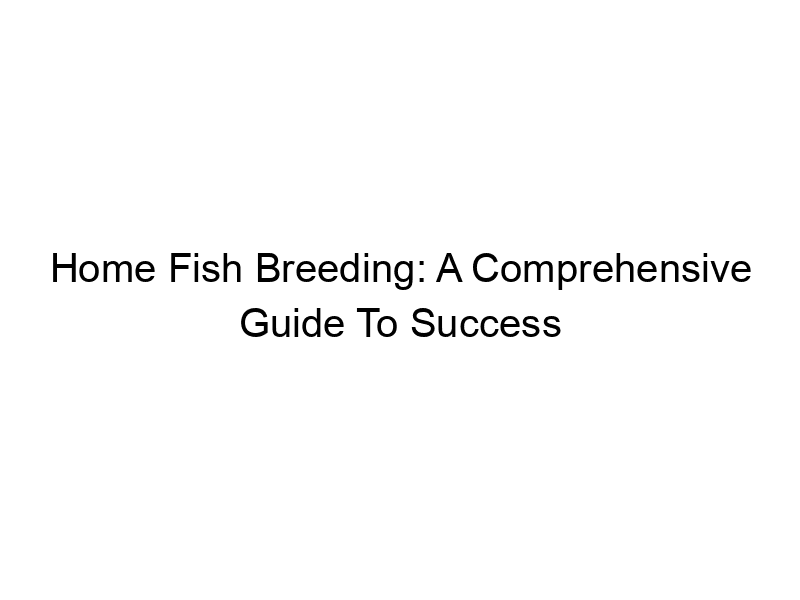Breeding fish at home can be a rewarding hobby, offering a fascinating glimpse into the natural world and the satisfaction of raising your own aquatic life. How to Breed Fish Successfully at Home is more than just a simple process; it requires understanding the intricacies of fish biology, water parameters, and breeding behavior. This comprehensive guide will equip you with the knowledge and practical steps to successfully breed various fish species at home, from selecting the right species to nurturing the fry. We’ll cover everything from setting up the ideal breeding tank to troubleshooting common problems, ensuring you’re well-prepared for this exciting endeavor.
Fish reproduction varies widely depending on the species. Some species are egg-layers (oviparous), releasing eggs that are externally fertilized by the male. Others are livebearers (viviparous), giving birth to live young.
Still others are ovoviviparous, retaining fertilized eggs internally until they hatch. Understanding your chosen species’ reproductive strategy is paramount to success. This includes learning about their spawning behavior, preferred habitats, and environmental cues that trigger breeding.
Recognizing Breeding Behaviors
Before spawning, many fish species exhibit specific behavioral changes. Males might become more brightly colored, build nests, or engage in elaborate courtship displays. Females often become fuller-bodied as their eggs develop. Observing these behaviors is crucial for determining the optimal time to intervene and assist with the breeding process. Keep detailed notes on your fish’s behavior to establish a baseline for recognizing these changes.
Choosing the Right Fish Species
Beginner-Friendly Species
For beginners, it’s advisable to start with hardy and relatively easy-to-breed species. Guppies, mollies, and platys are excellent choices for livebearers, requiring less specialized care than egg-layers. Some egg-laying species like Bettas (Siamese Fighting Fish) are also manageable for beginners, but require careful attention to water parameters and nest building.
Advanced Species
Once you’ve gained experience, you can explore breeding more challenging species. African cichlids, for instance, exhibit complex social hierarchies and breeding behaviors, demanding a deeper understanding of their specific needs. Discus fish, known for their beauty and delicate nature, require expert-level care and advanced breeding techniques. Thorough research is essential before attempting to breed more demanding species.
Setting Up the Breeding Tank
Tank Size and Filtration
The size of the breeding tank depends on the species and the number of fish you intend to breed. It should provide ample space for the fish to comfortably move around and avoid overcrowding. A robust filtration system is crucial to maintain water quality, as ammonia and nitrites can be fatal to developing eggs and fry. Consider using a sponge filter for gentler water movement.
Water Parameters
Maintaining optimal water parameters is crucial for successful fish breeding. This includes temperature, pH, and hardness, all of which should align with the specific needs of your chosen species. Regular water testing using a reliable test kit is essential. Consider using a heater and an air pump to ensure stable conditions. Note that fluctuations in water parameters can disrupt breeding cycles and reduce success rates.
Preparing the Breeding Pair
Conditioning the Breeders
Before introducing the breeding pair to the breeding tank, it’s essential to condition them properly. This involves providing a diet rich in live or frozen foods to stimulate their reproductive systems. High-quality fish flakes supplemented with bloodworms, brine shrimp, or daphnia can encourage healthy egg production and increased fertility.
Selecting Healthy Breeders
Choosing healthy, mature breeders is critical. Avoid fish exhibiting signs of illness or stress. Look for vibrant colors, full bodies, and active behavior. Breeding unhealthy fish often results in poor egg fertilization rates and weak fry. A well-nourished and stress-free breeding pair is more likely to successfully reproduce.
The Spawning Process
Monitoring the Spawning Event
Once the breeding pair shows signs of readiness, they will typically begin spawning. For egg-layers, this involves the female releasing eggs, which are then fertilized by the male. For livebearers, the female will carry the fertilized eggs internally until giving birth to live young. Closely monitor the spawning process, but avoid disturbing the fish.
Providing a Suitable Spawning Substrate
Some egg-laying species require a specific spawning substrate, such as smooth rocks, plants, or a spawning mop. This provides a place for the female to deposit her eggs, ensuring their safety and promoting successful fertilization. The type of substrate should be species-specific.
Raising the Fry
Separating Parents from Fry
After spawning, it’s often necessary to remove the parents from the breeding tank to prevent them from eating their eggs or fry. This can be achieved by transferring the parents to a separate tank or using a breeder box within the breeding tank. This protection is vital for the survival of the young.
Feeding the Fry
Newly hatched fry require a diet of infusoria, rotifers, or newly hatched brine shrimp. These tiny organisms are small enough for the fry to consume. As the fry grow, they can be gradually introduced to larger food items, such as crushed flake food.
Water Changes and Maintenance
Regular Water Changes
Regular partial water changes are essential to maintain water quality in the breeding tank. This helps to remove waste products and prevent the buildup of harmful substances. Aim for 25-50% water changes every few days or as needed, depending on the size of the tank and the number of fish.
Maintaining Water Parameters
Consistent monitoring of water parameters is critical throughout the breeding and fry-raising process. Regularly test for ammonia, nitrite, and nitrate levels. Adjust parameters as needed to ensure they remain within the optimal range for the fish. Water parameters should be closely controlled for best results.
Troubleshooting Common Problems
Egg or Fry Mortality
Egg or fry mortality can be caused by various factors, including poor water quality, inadequate nutrition, or the presence of diseases or parasites. Identifying the cause is crucial for addressing the issue and preventing further losses. Regular checks and water testing are key preventive measures.
Parental Aggression
Some species exhibit parental aggression towards their eggs or fry. This behavior can lead to significant losses. If you observe this, consider removing the parents from the breeding tank. Alternative options are using divider screens or using a different breeding methodology.
Advanced Breeding Techniques
Artificial Spawning
Artificial spawning techniques can be used for species that are difficult to breed naturally. This involves manually stripping eggs and sperm from the fish and then fertilizing them externally. This requires specific knowledge and equipment.
Incubation Methods
Various methods can be used to incubate fish eggs, such as incubators, jar incubation, or using a hatching tray within the tank. The most appropriate method depends on the specific needs of the species. The aim is to provide a suitable and stable environment for eggs to hatch successfully.
Benefits of Home Fish Breeding
Conservation Efforts
Home fish breeding can contribute to conservation efforts by reducing the demand for wild-caught fish, thereby protecting natural populations. This practice is gaining increasing importance.
Educational Opportunities
Breeding fish provides valuable educational opportunities, teaching patience, responsibility, and an appreciation for the natural world. It can be a wonderful learning experience for adults and children alike.
Limitations of Home Fish Breeding
Space and Time Commitment
Home fish breeding requires a significant time and space commitment. It’s not a hobby that can be undertaken lightly. You will need adequate space, equipment, and time to properly care for the fish and their offspring.
Potential for Disease Outbreaks
Breeding fish carries the risk of disease outbreaks. Maintaining impeccable hygiene, performing regular water changes, and implementing quarantine procedures are crucial for preventing and managing diseases.
Comparing Different Breeding Methods
Livebearers vs. Egg-layers
Livebearers and egg-layers differ significantly in their breeding requirements. Livebearers generally require less specialized setup, while egg-layers require more attention to water parameters and spawning substrates. Choosing between the two depends on your experience level and resources.
Open Tank vs. Closed System
Open tank systems are more accessible and easier to set up, but they require more frequent water changes. Closed systems require specialized equipment, but they can be more efficient in terms of water maintenance. The choice depends on individual needs and resources.
Frequently Asked Questions
What is the ideal water temperature for breeding fish?
The ideal water temperature varies greatly depending on the species of fish. Some prefer cooler temperatures, while others require warmer water. Always research the specific temperature requirements for your chosen species.
How often should I feed my fish during breeding?
During breeding, feed your fish multiple small meals per day, providing a diet rich in live or frozen foods. This ensures adequate nutrition for successful reproduction.
What should I do if my fish are not spawning?
If your fish are not spawning, ensure that their environmental conditions are optimal and that they are healthy and well-nourished. Consider adjusting water parameters, providing more hiding spaces or spawning substrates, or trying a different breeding method.
How do I know if my fish eggs are fertilized?
Fertilized fish eggs are usually cloudy or opaque, while unfertilized eggs are clear. However, the appearance can vary depending on the species.
How do I prevent my fish from eating their eggs or fry?
To prevent this, remove the parents from the breeding tank after spawning or use a breeder box to separate the parents from their offspring. This is crucial for the survival of the offspring.
Final Thoughts
Successfully breeding fish at home is a challenging yet immensely rewarding endeavor. It demands patience, dedication, and a deep understanding of the specific needs of your chosen species. By carefully following the guidelines outlined in this comprehensive guide, you can increase your chances of success and enjoy the wonder of raising your own aquatic life. Remember that ongoing research and observation are key to successful breeding. Don’t be discouraged by initial setbacks; each attempt provides valuable learning experiences. Whether you are a seasoned aquarist or a curious beginner, the world of fish breeding offers endless fascination and opportunities for growth. Start your journey today and experience the joy of witnessing the miracle of life unfold in your own home aquarium.




